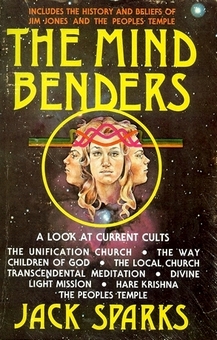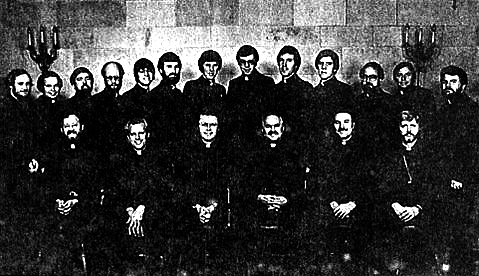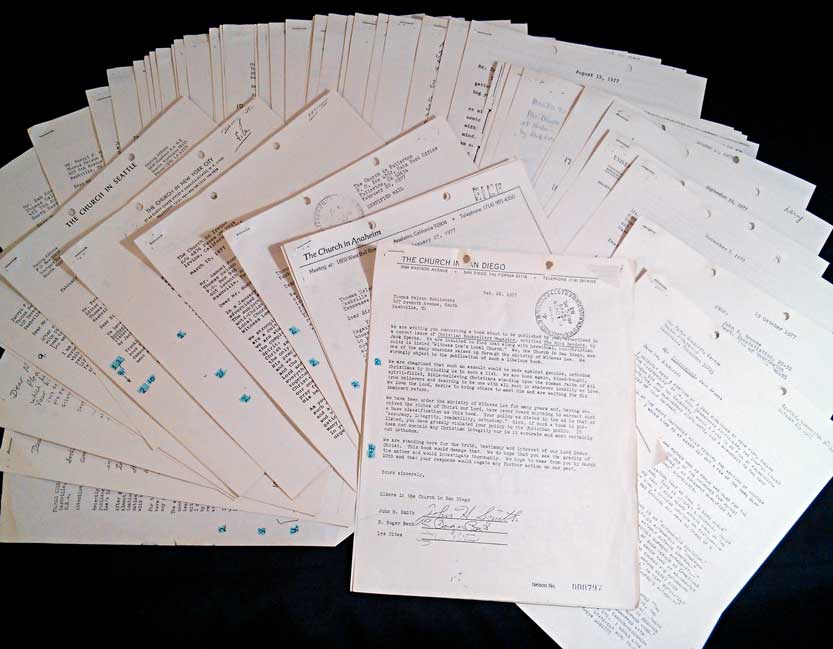In 1980 various local churches and church members filed separate libel suits in California, Georgia, Ohio, and Texas against Thomas Nelson Publishers, Jack Sparks, Jon Braun, Richard (Dick) Ballew, Peter Gillquist, et al over the publication of The Mindbenders: A Look at Current Cults by Jack Sparks. These suits were consolidated for discovery purposes. All four cases were resolved in one action when all of the defendants signed an agreement to withdraw the book and pay for damages and for Thomas Nelson Publishers to publish a retraction of and apology for The Mindbenders in major newspapers and Christian periodicals throughout the United States.

Background
For a general background of the events leading up to the writing of The Mindbenders, see “Prelude to Conflict: Christian World Liberation Front (CWLF), the New Covenant Apostolic Order (NCAO), the Spiritual Counterfeits Project (SCP), and the Local Churches.”
An Odd Blend
In 1973, after four years at the helm of CWLF, Jack Sparks began meeting with some of his old colleagues who had also left Campus Crusade, including Jon Braun, Dick Ballew, and Peter Gillquist. Together the men began to chart a new course. They concocted an odd blend that incorporated elements of evangelicalism, Eastern Orthodoxy, and the authoritarian extremes of the Shepherding movement. When Sparks sought to assert his authority as an “apostle” over CWLF members and convert CWLF into a church along these three lines, the group fractured, and Sparks left.1 That fall Sparks and six former Crusade leaders formed the New Covenant Apostolic Order (NCAO).2 The NCAO leaders claimed both apostolic succession and authority.
The Evangelical Orthodox Church (EOC)
In February 1979 the NCAO formed its associated congregations into the Evangelical Orthodox Church (EOC). Not surprisingly the NCAO’s leaders ordained one another as its bishops. That spring the EOC came under sharp criticism from, among others, Bill Counts, a former Campus Crusade member who had joined author Hal Lindsey at J. C. Light & Power House in Los Angeles. In a paper published by Spiritual Counterfeits Project (SCP), Counts criticized the NCAO leaders for exercising excessive control over the personal lives of its members.3

Front Row (L to R): Jack Norman Sparks, Jon E. Braun, Peter E. Gillquist, Kenneth A. Berven, J. Richard Ballew, Gordon Thomas Walker. Back Row: C. William Blythe, Weldon M. Hardenbrook, C. Ronald Roberson, Kenneth G. Jensen, Frederick C. Rogers, Timothy McCoy, Melvin E. Gimmaka, Jerold R. Gliege, Joseph W. Copeland, Dale S. Autrey, E. Wayne Wilson, Harold Dunaway, Robert H. Guin.
The EOC called for a return of the church to the teaching of the church fathers and the historic Christian creeds, that came to include a return to icons4, the use of incense5, and the veneration of Mary6. Timothy Weber, who at the time was Dean of the Seminary and Professor of Church History at Northern Baptist Theological Seminary, commented:
The search for the original church had led these unsuspecting American evangelicals into a world of strange sights, sounds, and smells: clouds of incense, elaborate vestments, prayers to the saints and for the dead, and veneration of the Mother of God and the holy icons, some of which even wept occasionally.7
Weber added that the EOC leaders increasingly veered from the evangelical view that “salvation is a gift of God’s grace that comes to sinners through their faith in Christ.”8 Thus, they became evangelical in name only.
“War”
The NCAO leaders realized that Witness Lee and the local churches with their emphasis on the Bible as the unique measure of Christian life and practice were a major obstacle to their ambitions. Having earlier seen young people leave groups of which they had been leaders to meet with the local churches, Sparks and the other “apostles” made a collective decision to “declare war” on the local churches and the ministry of Witness Lee. When Peter Gillquist, NCAO’s presiding apostle, got a job with Thomas Nelson Publishing as its new books editor, the first book Gillquist commissioned was The Mindbenders. According to Sparks, the local churches were included in the book at Gillquist’s insistence. Jon Braun wrote the chapter on the local churches out of bitterness over his treatment by Gene Edwards, who had left the local churches to fulfill his own ambitions.9 Braun’s source materials included a monograph written by Alan Wallerstedt, a follower of Jack Sparks. Wallerstedt, in turn, had written his piece based on a 1972 tape recording made by Braun and talks given by Sparks in 1973 to CWLF members.10
The Mindbenders claimed to refute the “most dangerous cults.” It falsely accused the local churches of practicing brainwashing and said “the brainwashing, or mindbending, of the Local Church is, I believe, the most powerful and lasting of any cult on the contemporary scene” (p. 226). It claimed the local churches used fear to keep members and called Witness Lee “the autonomous dictator of this world-wide religious cult” (p. 221). It said the local churches suppress individuality, making group identity and acceptance all-important, and that many who had been involved with the local churches had been emotionally devastated and that their minds no longer functioned normally. Interestingly, many of these same charges were made against the EOC in the SCP/Bill Counts article previously mentioned, and one of the false accusations made in Sparks’ book—that the local churches intended to steal members from other Christian groups—was actually a reflection of EOC′s own stated intentions.
The chapter on the local churches in The Mindbenders was a case study in the abusive practice of using quotes out of context. The following is one classic example:
They cease being able to relate normally either amongst themselves or those outside their “church” in the everyday relationships of life, such as husband-wife, parent-child, and employer-employee. Indeed, Lee encourages abnormality in such relationships:
Have you seen God, Christ, the Church, and the Churches? The sisters must forget about their husbands, and the brothers must forget about their wives. We must forget about our preoccupations and see God, Christ, the Church, and the churches. Hallelujah!
(The Mindbenders, p. 238)
Read in its full context Witness Lee’s statement has nothing to do with neglecting human relationships. The point he was making was that although the Bible addresses many subjects, as a whole it reveals that God intends to have the church as the Body of Christ expressed in many churches. Thus, the main figures in the Bible are God, Christ, the church, and the churches. However, when we as Christians read the Bible, we may be preoccupied with personal interests, such as our relationships with our spouses, so we tend to focus on the verses that tell us to love our wives or submit to our husbands. In doing so, we may miss the central message of the Bible. For that reason, he urged his listeners to forget about their own preoccupations when they come to God’s Word and to seek to see what God reveals there of His ultimate goal and purpose.11
Some of the Nelson staff and their outside reviewers who read The Mindbenders before its release recommended that it be dropped due to its obvious bias and lack of substantive supporting research. One staff member, Craig Lampe (later International Director of the World Bible Society), was familiar with the writings of Watchman Nee and Witness Lee and strongly protested the book’s inaccuracies. He also testified that The Mindbenders was fraught with false accusations against the local churches. Members of the local churches wrote nearly 300 letters to the publisher and author, protesting their inclusion in the book and its distortion of their beliefs and practices. All appeals were ignored. After the Jonestown tragedy in 1978, a second edition of The Mindbenders was printed with a chapter on Jim Jones and the Peoples’ Temple immediately following the chapter on “The Local Church of Witness Lee.”

Letters written by members of the local churches to the author and publisher protesting the books
The Lawsuit and Its Result
In the face of seemingly insurmountable opposition and losses, libel litigation was initiated against Thomas Nelson and the EOC bishops most directly involved in the production of The Mindbenders. This action was taken only after representatives of the churches made numerous attempts to seek corrective action and gave thorough consideration to the propriety of filing a lawsuit against fellow believers.12 The lawsuit over The Mindbenders lasted from May 1980 to April 1983, at which time Thomas Nelson, Jack Sparks, Jon Braun, Dick Ballew, and Peter Gillquist signed a settlement agreement that included the publication of a retraction and apology in major newspapers and Christian periodicals across the country.
 Copy of the retraction issued by Thomas Nelson and the EOC
Copy of the retraction issued by Thomas Nelson and the EOC
Aftermath
The NCAO/EOC’s attempt to blend evangelicalism, Eastern orthodoxy, and Shepherding movement principles left them in a spiritual no man’s land. The National Association of Evangelicals tabled their application for membership, partly over concerns about authoritarianism.13 The Eastern Orthodox tradition only recognizes groups that can claim historical apostolic succession, which the NCAO could not do. The EOC sought admission to recognized orthodoxy first through the Orthodox Church of America, which had its own concerns about the EOC’s authoritarian practices. The EOC leaders then sought audience with the Ecumenical Patriarchate of Constantinople but were turned away. Eventually, the NCAO leaders and most of the EOC churches were chrismated into the Antiochian Orthodox Christian Archdiocese of North America.14

As for the local churches, the settlement of The Mindbenders case demonstrated the truth of the local churches’ claims that the book’s portrayal of them was false and defamatory. The end of The Mindbenders litigation also freed up resources to press forward with the libel case over The God-Men.
Notes:
1 Edward E. Plowman, “Whatever Happened To the Jesus Movement,” Christianity Today 20:2, October 24, 1975:46-48.
2 Ruth Stiling, “An Examination of the Evangelical Orthodox Church” (M.A. thesis, Dallas Theological Seminary, 1980), 19.
3 Bill Counts, “The Evangelical Orthodox Church and the New Covenant Apostolic Order,” Spiritual Counterfeits Project, Spring 1979; others who have pointed out this tendency include Lloyd R. Thompson, “A Critical Analysis of the Evangelic Orthodox Church (New Covenant Apostolic Order),” (Ph.D. diss., Yale Divinity School, 1979), 35; Stiling, 22; Steve Barth, “Local Church a ‘Potentially Dangerous Situation’: Sources Say EOC has Total Authority Over Members” Daily Nexus, November 12, 1979: 1; Bruce Wollenburg, “The Evangelical Orthodox Church: A Preliminary Appraisal,” The Christian Century 97:23, July 2, 1980: 700.
4 See “No Graven Image,” by Fr. Jack N. Sparks, Ph.D.
5 See “The Evangelical Orthodox Church: Questions & Answers”. Many other Web sites can be found using the search term “incense” with “Evangelical Orthodox Church” or “Gillquist.”
6 “Our Blessed Mother and Blessed Bread,” published on the Web site of St. Athanasius Orthodox Church, a former EOC congregation in Isla Vista, CA, gives the following account of a practice derived from a fabricated extrabiblical account of what the apostles supposedly witnessed at the burial of Mary, the mother of Jesus:
…Raising their eyes, they beheld, standing in the air, the Theotokos, who was accompanied by a multitude of angels. She said to the Apostles, “Rejoice, for I am with you all the days of your lives!” Upon seeing her, they were filled with joy and cried aloud, “Most Holy Mother of God, save us!”
It is from this event that the Church derives a custom of offering up bread at the remembrance of “our all-holy, immaculate, most blessed and glorious Lady Theotokos and Ever-virgin Mary” during the Divine Liturgy. While the hymn to the Theotokos is chanted, the priest receives the baskets of bread, saying, “Great is the name of the Holy Trinity!” He then elevates the baskets, making with them the sign of the Cross and saying, “Most Holy Theotokos, save us!”…
See also “Facing Up to Mary,” by Fr. Peter E. Gillquist.
7 Timothy P. Weber, “Looking for Home: Evangelical Orthodoxy and the Search for the Original Church,” Eastern Orthodox Theology: A Contemporary Reader, Daniel B. Clendenin, ed., 2nd ed. (Grand Rapids, MI: Baker Academic, 2003), 264.
8 Ibid., 268.
9 Deposition of Gordon Walker, February 3, 1981: 45; Interview with Ray Nethery, August 1, 1980.
10 Deposition of Jack Sparks, November 16, 1981, 318-319; Deposition of Jon Edward Braun, December 19, 1981, 610; Deposition of Alan Wallerstedt in Lee et al v. Duddy et al, April 6, 1983; 607-612.
11 Witness Lee, “God’s Revelation and God’s Recovery,” The Stream VII:4, November 1, 1969: 11.
12 For a discussion of this issue, see “Is Our Appeal to the Courts in Accordance with Scripture?“
13 Billy A. Melvin, letter to Peter Gillquist, April 10, 1985, National Association of Evangelicals Papers (SC-113), Wheaton College Special Collections, Wheaton, IL.
14 Peter Gillquist gives a detailed but hardly unbiased account in his book Becoming Orthodox: A Journey to the Ancient Faith (Ben Lomond, CA: Conciliar Press, 1989). More balanced accounts appear in D. Oliver Herbel, Turning to Tradition: Converts and the Making of an American Orthodox Church (New York: Oxford University Press, 2014); Joseph H. Fester, “The Evangelical Orthodox Church and Its Dialogue with the Orthodox Church in America” (M.Div. thesis, Crestwood, NY: St. Vladimir’s Orthodox Seminary, 1982); Timothy P. Weber, op. cit., 249-272. Of Gillquist’s rendition Herbel, an OCA priest, comments:
Although it could be debated whether one ought to consider the NCAO-ECO an authoritarian “cult,” an overly sanitized narrative, which one encounters from Gillquist and the other former EOC members who have published their conversion narratives, certainly fails to discuss the group’s clear sectarian and cultish tendencies. (114)